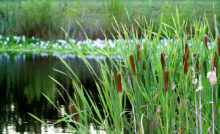Water – The Single Biggest Input


What do you apply on your golf course more than anything else? 15 to 20 years ago, the most common answer would be nitrogen, or calcium; water was never a consideration. Ask that same question today, the answer many times will be WATER. With increased use of recycled water and deteriorating ground water quality, nutrient loads are getting larger. We are being reactive with soil testing to correct poor base saturation cation balance (Calcium, Magnesium, Potassium and Sodium) in the water, then typically amend the soil to balance and combat the detrimental constituents, such as too much sodium, chloride, sulfate, and let’s not forget bicarbonate. For those who are blessed with using pure water sources… infiltration, percolation and potential for nutrient stripping is a concern. If you are using poor water quality, be careful with what, and how much you apply, or you can induce your own salinity issues. Sometimes, it’s not what you didn’t do that causes problems, it’s what you did do. As we enjoy the benefits of rain, cleaning up the soil, and in some cases having drought restrictions lifted, higher prices for water will still prevent many Superintendents from implementing leaching fractions to prevent accumulation of detrimental salts in the root zone by applying more water than is needed for Evapo-Transpiration (ETo). In the Southwest for example, as they head into their long stretch with little or no rainfall, reductions in water use will favor salt accumulation. We have learned to become better environmental stewards by irrigating at about 60% of ETo on warm season grass, with 70% to 80% of ETo being applied to cool season turf varieties. Due to this water conservation strategy, other methods should be considered to maximize salt management. Good soluble sources of calcium, penetrants to aid water movement and depth of penetration, carboxylic and other organic acid(s), including aminated compounds work well, but keep in mind that salt management starts with water movement and drainage. Innovative water treatment systems can help by reducing surface tension, drive salts deeper in the root zone, prevent scale formation in irrigation piping and maintain water flow for better distribution uniformity, such as Magnation (rainlikewater.com). We should also take into consideration “Sufficiency Levels of Available Nutrients” (SLAN), and target the right nutrient levels based on the site-specific challenges and targets.
Management strategies should be applied in front of potential problems to be more proactive. Two (2) items that can assist turf managers with pro-active water management are:
- Greens Irrigation Normalization Spreadsheet available through the USGA
(pictured below – www.usga.org/course-care.html)
This unique spreadsheet was created based on greens not being the same size and sometimes having a different number of heads. This tool allows the turf manager to adjust for the individual size of each green, the number of heads and sprinkler flow rate(s). This will work to promote equal water distribution as opposed to smaller greens getting more water and larger greens getting less. Once the basic adjustments are made, then further fine tuning can be done to address site-specific nuances on greens such as different root zones, location of the green, air movement and/or shade issues, surrounding tress impacting water use, etc.
- The second helpful tool is available through STS Turf, and is a Nutrient Contribution – Amendment Application Spreadsheet, which helps turf managers identify site-specific water challenges. The first item is inputting water-based constituents, then calculating the volume of water that will be used, with the spreadsheet formulas providing the number of acre-feet of water applied per acre, specific to certain areas, while also illustrating when the greatest amount of water will be applied. This will work to quantify the constituent contribution and compensate for the time of year when irrigation water use is at its’ greatest. The objective is to first balance the soil, then pro-actively manage by establishing an amendment schedule structured to compliment any soil type and/or situation based on water quality and input. This enables the user to proactively maintain ideal soil content and balance, as opposed to reacting to soil testing and making corrections after the fact, thus soil testing becomes more of a monitoring tool as opposed to a reactionary tool.
When using pure water, this spreadsheet allows the end-user to determine what should be applied, how much and how often to target nutrient goals.
The STS Turf spreadsheet has been continually fine-tuned over the past 15 years since being first exposed to the use of recycled water and the impact it had on the soil chemistry. This proprietary spreadsheet will also work to help prevent overloading of amendments and / or N-P-K fertilizer to reduce potential of creating a self-induced salinity hazard by putting out too much, either at one time or over the duration of the amendment schedule. Using poor water quality, it is many times difficult to achieve an ideal Calcium to Sodium ratio, otherwise you take the chance of overloading.
Once you know how much you should apply to off-set the water contribution (let’s say sodium), then you can work on correcting the balance of Ca-Mg-K. Using recycled water for example, Potassium typically is significantly lower than Calcium and Magnesium, and in the presence of high sodium when turf cannot differentiate between the two single positive charged cations it becomes important to foliar feed Potassium in addition to amending the soil to prevent issues.
An abbreviated list of detriments these tools can help you manage include:
The Sodium Adsorption Ratio, or SAR, which quantifies the potential sodium hazard of water based on the variety of turf being managed. This value determines the relative proportion of sodium, compared to calcium and magnesium. As the SAR value increases, so does the sodium hazard to soil and low tolerant turf.
The adjusted SAR was developed to account for the sodium hazard of the water due to the SAR, while factoring in the bicarbonate (HCO3) concentration and its’ precipitation potential converting soluble calcium and magnesium into insoluble lime. Bicarbonate adversely affects plant balance, soil structure, and the uptake and metabolism of nutrients in the plant. Lime-induced iron chlorosis can occur, especially late in the growing season. Acidifying will help decompose bicarbonate before it has a chance to create issues.
High sodium can adversely affect soil structure and aggregation, limit water infiltration, percolation, aeration, gas exchange and pore space where roots can grow. Water moves from an area of low salt concentration to an area of high salt concentration.
High chloride can cause leaf burn, premature leaf drop, stem dieback, and inhibits plant growth and root development. It can also impact Nitrogen uptake, with high chloride sometimes dictating increased Nitrogen inputs.
Sulfur deficiencies result in chlorosis, but when high in the water, restricts N in a poor ratio, can tie up metals, and react and convert into ferrous or hydrogen sulfide (black layer). If toxic gases cannot vent, they can damage roots, resulting in turf decline and loss. High sulfur can also limit uptake of calcium. Calcium deficiency symptoms can occur when sulfate levels are too high, as well as when plants stress due to high temperature, winds, or low soil moisture. Sulfur in the profile can react with sodium, to form sodium sulfate, which like sodium chloride, is very soluble.
When looking to manage your growing medium, light, air and water should always be addressed as the foundation to ensure nutrient inputs work efficiently. Manage water movement, drainage and quality before it manages you.
The Author:
Brad Snavely – Technical Director of Sustainable Turf Science, Inc. has a combined 40 years of experience in agriculture and sports turf management. Brad consults world-class sports stadiums, Top 100 golf courses as well as lower level facilities, municipalities and sports complexes to maximize their budget dollar while promoting turf quality and stress resistance. STS Turf – Next Generation Turf Nutrition is the industry leader for enzymatic fragmentation / pre-digestion yielding nutrients stabilized in ionic form along with organic acids, carbon, bio-stimulants, vitamins and enzymes to optimize turfs’ genetic potential.
Recent Posts
South Carolina State Leaders Honor Green’s Superintendent Career
South Carolina’s House of Representatives today honored the career of golf course superintendent Chuck Green.…
Branson, Missouri: 5 Reasons Why it is a Must-Visit Travel and Golf Destination
Branson, Missouri, is booming as a must-visit destination for golf enthusiasts and travelers alike. Nestled…
Preview more than 1,000 rounds of golf available in GCSAA’s Rounds 4 Research online auction
The Golf Course Superintendents Association of America (GCSAA) Rounds 4 Research program offers golfers the…
EcoBunker Synthetic Revetting More Sustainable than Natural Turf*
*A recent report by the Welsh government has found that EcoBunker synthetically revetted bunkers have…
SiteOne® Hires Dan Carrothers as VP, Agronomic Business Development
SiteOne® Landscape Supply is pleased to announce Dan Carrothers as the new Vice President for…
Superintendents Online Turf Directory – EVERYTHING TURF
Our online directory, directory.GolfCourseTrades.com is the go-to resource for the busy superintendent. It is your opportunity…


